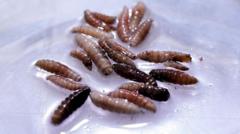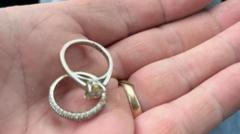Is the Flesh-Eating Screwworm Parasite Now a Threat in the US?

Published: 2025-08-25 21:18:16 | Category: world
The first human case of New World screwworm (NWS) myiasis has been reported in the United States, marking a significant public health concern. This parasitic infestation is caused by the larvae of parasitic flies that typically affect livestock but can also infest humans, especially those with open wounds. The case, confirmed on 4 August after a patient returned from El Salvador, has prompted investigations by health authorities, although the overall risk to public health remains low.
Last updated: 06 October 2023 (BST)
Key Takeaways
- The first human case of NWS myiasis in the US was confirmed on 4 August 2023.
- The infected individual had travelled to El Salvador, a known outbreak region.
- New World screwworm primarily affects livestock but can infest humans under certain conditions.
- Authorities have stated that the current risk to public health is "very low."
- The USDA and CDC are collaborating to manage and investigate the outbreak.
Understanding New World Screwworm Myiasis
New World screwworm myiasis is caused by the larvae of the *Cochliomyia hominivorax* fly, which is notorious for feeding on the living tissues of animals and, in rare cases, humans. This condition primarily affects livestock, leading to severe health issues and economic losses in the agricultural sector. The larvae can cause extensive damage as they burrow into the flesh, leading to infections, secondary infestations, and even death if left untreated.
The Lifecycle of the New World Screwworm
The lifecycle of the NWS involves several stages:
- Adult flies lay eggs on open wounds or mucous membranes of hosts.
- After hatching, the larvae begin to feed on the living tissue.
- The larvae develop through several instar stages before falling to the ground to pupate.
- Adult flies emerge from the pupae, continuing the cycle.
Geographical Spread and Risk Factors
Historically, NWS myiasis has been endemic to areas in South America and the Caribbean. However, the pest has made its way into every Central American country, including Mexico, raising alarms about its potential spread into the US. The risk of infestation is particularly high for individuals who travel to these regions or those who work closely with livestock.
Symptoms and Diagnosis of NWS Myiasis in Humans
Symptoms of NWS myiasis in humans can include:
- Severe pain at the site of infestation
- Inflammation and swelling
- Visible larvae in the wound
- Foul odour emanating from the wound
- Fever and other systemic symptoms in severe cases
Diagnosis typically involves a physical examination and identification of the larvae in the affected area. Treatment usually requires the careful removal of the larvae, along with potential antibiotic therapy to prevent infection.
Public Health Implications
While the confirmed case in the US is concerning, health officials have reiterated that the risk to the general public is currently very low. The Centers for Disease Control and Prevention (CDC) and local health departments are actively monitoring the situation. They have advised potential travellers to endemic regions to take precautions, such as avoiding contact with livestock and seeking medical attention for any open wounds.
Economic Impact of a Screwworm Outbreak
The USDA has warned that an outbreak of NWS in livestock could have devastating economic consequences, potentially threatening over £73.9 billion in economic activity linked to the cattle and livestock industry. The effects could extend beyond immediate agricultural losses to impact food supply chains and local economies reliant on livestock production.
Preventative Measures and Control Strategies
Authorities are implementing several strategies to control the spread of New World screwworms:
- Monitoring and surveillance of livestock and wildlife in potential outbreak areas.
- Public awareness campaigns to educate travellers about risks associated with NWS myiasis.
- Collaboration with international agricultural agencies to manage and respond to outbreaks.
- Use of pesticides and traps to reduce fly populations in affected regions.
What to Do if Infested
Individuals who suspect they have been infested should seek immediate medical attention. Do not attempt to remove the larvae yourself, as improper removal can lead to further complications. Early intervention is critical to preventing severe tissue damage and associated health risks.
Conclusion: What Happens Next?
The emergence of the first human case of New World screwworm myiasis in the US underscores the importance of vigilance in public health and agricultural practices. As health authorities continue to monitor the situation, it remains crucial for individuals, particularly those travelling to endemic regions, to be informed and cautious. The collaborative efforts between health departments and agricultural agencies will be pivotal in preventing further cases and controlling any potential outbreaks.
In a world where global travel is commonplace, the threat of parasitic infestations like NWS myiasis serves as a reminder of the interconnectedness of health and agriculture. How can we better prepare and respond to such challenges in the future? #PublicHealth #Screwworm #Myiasis
FAQs
What is New World screwworm myiasis?
New World screwworm myiasis is a parasitic infestation caused by the larvae of the *Cochliomyia hominivorax* fly, primarily affecting livestock but also capable of infesting humans.
How does one contract NWS myiasis?
Humans can contract NWS myiasis through direct contact with infested livestock or by having open wounds that attract the flies, particularly in endemic regions.
What are the symptoms of NWS myiasis in humans?
Symptoms include severe pain at the infestation site, inflammation, visible larvae, foul odour, and systemic symptoms like fever in severe cases.
What should I do if I suspect I have NWS myiasis?
If you suspect an infestation, seek immediate medical attention for proper diagnosis and treatment, including the removal of any larvae present.
How can NWS myiasis be prevented?
Prevention includes avoiding contact with livestock in endemic areas, keeping wounds clean and covered, and seeking medical advice when travelling to high-risk regions.



